Scotland's Coastal Revival: The Importance Of Seagrass Planting Initiatives

Table of Contents
The Ecological Importance of Seagrass Beds
Seagrass meadows are often overlooked, yet they are incredibly important ecosystems providing a multitude of benefits to our oceans and coastal communities. Their restoration is paramount for a healthy marine environment.
Carbon Sequestration and Climate Change Mitigation
Seagrass meadows are highly effective carbon sinks, absorbing carbon dioxide (CO2) from the atmosphere at a rate comparable to, or even exceeding, that of tropical rainforests. This "blue carbon" sequestration makes seagrass restoration crucial in combating climate change.
- Seagrass can bury carbon in the sediment, creating long-term "blue carbon" stores that remain locked away for millennia, effectively removing it from the atmosphere for centuries.
- Planting seagrass significantly helps reduce Scotland's carbon footprint and contributes to global climate change mitigation efforts, making it a key element of sustainable coastal management. This natural carbon capture process is a powerful tool in our fight against global warming.
Biodiversity Hotspots and Habitat Provision
Beyond carbon sequestration, seagrass beds are incredibly biodiverse habitats, teeming with life. They provide critical habitat for a wide range of marine species.
- They act as nurseries for juvenile fish, offering protection from predators and providing abundant food sources, ensuring the health of commercially important fish stocks.
- The intricate structure of seagrass beds supports a complex food web, increasing overall biodiversity and supporting a wide array of invertebrates, crustaceans, and fish species, leading to a healthier and more resilient ecosystem. This supports the entire marine food chain.
Coastal Protection and Erosion Control
The benefits of seagrass extend beyond the water's surface. These underwater meadows offer significant coastal protection.
- Seagrass meadows act as natural buffers against coastal erosion, reducing wave energy and stabilizing sediments. This natural protection is a cost-effective alternative to artificial structures.
- Their extensive root systems bind the seabed, preventing sediment loss and protecting shorelines from storm damage, mitigating the effects of increasingly severe weather events. This natural coastal defense is crucial for protecting Scotland's vulnerable coastlines.
Scotland's Seagrass Planting Initiatives: Current Projects and Successes
Several organizations and initiatives are actively involved in seagrass restoration across Scotland. These projects demonstrate the commitment to restoring this vital habitat.
- The Seagrass Ocean Rescue Project: This project, working in partnership with various Scottish organizations, has implemented successful seagrass planting projects along the west coast of Scotland, demonstrating positive results and increased seagrass coverage in target areas.
- Heriot-Watt University's research: Significant research is underway at Heriot-Watt University, exploring innovative techniques for seagrass cultivation and transplantation, leading to more effective and efficient restoration methods.
- Successful examples of seagrass planting show a significant increase in biodiversity, improved water quality, and enhanced coastal protection. These projects utilize advanced techniques, including drone surveys for monitoring and innovative planting methods.
For more information on specific projects and participating organizations, please visit [Insert links to relevant organizations and resources here].
Challenges and Future Directions for Seagrass Restoration in Scotland
Despite the success of existing projects, challenges remain in seagrass restoration.
- Pollution from agricultural runoff and industrial discharge continues to threaten seagrass health, highlighting the need for improved water quality management.
- Habitat loss due to coastal development and destructive fishing practices necessitates careful planning and sustainable coastal management strategies.
- The impacts of climate change, including rising sea temperatures and ocean acidification, pose significant threats to seagrass survival. Further research into climate change resilience in seagrass is crucial.
Further research, collaboration between government agencies, research institutions, and community groups, and robust public awareness campaigns are needed to ensure the long-term success of seagrass restoration in Scotland.
Conclusion
Seagrass planting initiatives are essential for Scotland's coastal revival. These projects offer a powerful, natural solution to climate change, enhance biodiversity, protect coastlines, and strengthen coastal resilience. By supporting and expanding these efforts – through volunteering, donations, or raising awareness – we can protect Scotland's valuable marine ecosystems and ensure a healthy future for our coastlines. Let's actively participate in the ongoing seagrass restoration projects and support initiatives that promote sustainable coastal management and the planting of seagrass. Get involved and help revitalize Scotland's coast!

Featured Posts
-
 Ajagba Vows To Dominate Bakole
May 05, 2025
Ajagba Vows To Dominate Bakole
May 05, 2025 -
 Bradley Cooper Directs Will Arnett On Is This Thing On Nyc Set Photos
May 05, 2025
Bradley Cooper Directs Will Arnett On Is This Thing On Nyc Set Photos
May 05, 2025 -
 Gymnast Simone Biles To Announce Riders Up At Kentucky Derby
May 05, 2025
Gymnast Simone Biles To Announce Riders Up At Kentucky Derby
May 05, 2025 -
 Comment Eviter Les Erreurs Fatales Guide Pratique
May 05, 2025
Comment Eviter Les Erreurs Fatales Guide Pratique
May 05, 2025 -
 Nuggets Front Office Responds To Westbrook Controversy
May 05, 2025
Nuggets Front Office Responds To Westbrook Controversy
May 05, 2025
